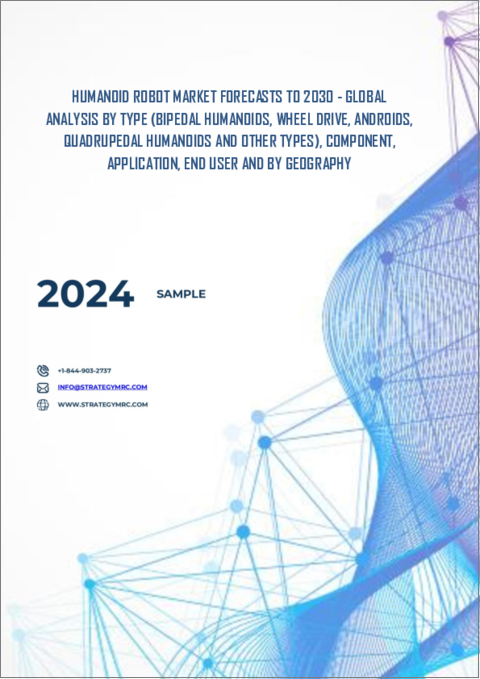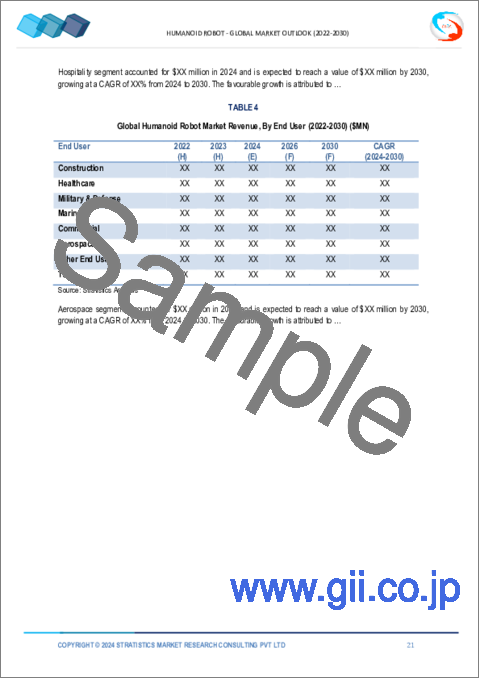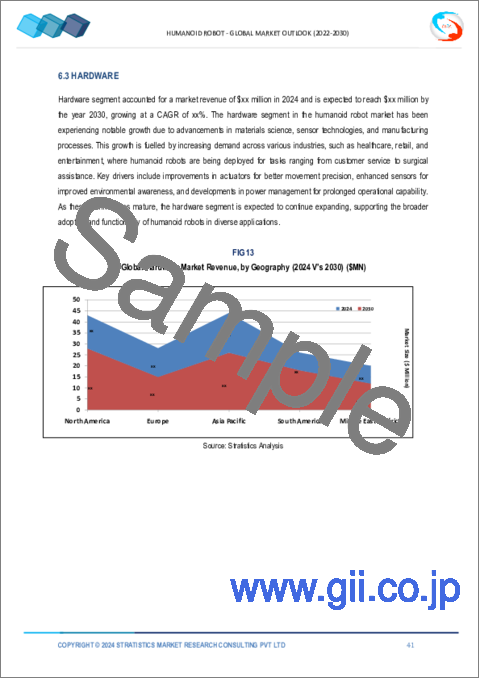|
|
市場調査レポート
商品コード
1494761
ヒューマノイドロボット市場の2030年までの予測: タイプ別、コンポーネント別、用途別、エンドユーザー別、地域別の世界分析Humanoid Robot Market Forecasts to 2030 - Global Analysis By Type (Bipedal Humanoids, Wheel drive, Androids, Quadrupedal Humanoids and Other Types), Component, Application, End User and By Geography |
||||||
カスタマイズ可能
|
|||||||
| ヒューマノイドロボット市場の2030年までの予測: タイプ別、コンポーネント別、用途別、エンドユーザー別、地域別の世界分析 |
|
出版日: 2024年06月06日
発行: Stratistics Market Research Consulting
ページ情報: 英文 200+ Pages
納期: 2~3営業日
|
全表示
- 概要
- 図表
- 目次
Stratistics MRCによると、世界のヒューマノイドロボット市場は2024年に27億米ドルを占め、予測期間中のCAGRは52.2%で成長し、2030年には340億米ドルに達すると予測されています。
ヒューマノイドロボットとは、人間の外見、行動、解剖学的構造をある程度模倣したロボットのことです。これらのロボットは通常、頭部、胴体、腕、脚など、人間と同様の身体構造を持っています。また、視覚、聴覚、触覚などの感覚機能を備えている場合もあり、より自然な方法で環境や人間と相互作用することができます。ヒューマノイドロボットは多くの場合、歩行、物体の把持、会話など、人間の動作を模倣したタスクや機能を実行するように設計されています。ヒューマノイドロボットは、研究、エンターテインメント、教育、ヘルスケア、産業などさまざまな分野で使用されており、技術の進歩や人間と機械の相互作用の改善を目的としています。
自動化需要の高まり
産業界が効率的で汎用性の高いロボットソリューションを求める傾向が強まるにつれ、市場では自動化需要が急増しています。AIやロボット技術の進歩に伴い、人間の動作を模倣し、さまざまな環境でシームレスに相互作用できるヒューマノイドロボットへの嗜好が高まっています。製造業やヘルスケアからカスタマーサービスやエンターテインメントに至るまで、プロセスを合理化し、生産性を向上させ、パーソナライズされた体験を提供するための自動化のニーズが、市場の急速な拡大を後押ししています。
厳しい政府規制
同市場は、厳しい政府規制による大きな課題に直面しています。これらの規制は、安全性、プライバシー、倫理的使用の確保を目的としており、多くの場合、広範なコンプライアンス対策が必要となるため、製造コストと市場投入までの時間が増大します。さらに、さまざまな地域にまたがる多様な規制の枠組みをナビゲートすることは、メーカーに複雑さと不確実性をもたらします。このような規制は、社会的受容と責任ある開発にとって極めて重要ですが、世界規模で人型ロボットの革新と商業化を目指す企業にとってはハードルとなります。
医療分野からの需要の高まり
ヘルスケア現場における高度な支援の必要性から、医療分野からの需要が急増しています。これらの人型ロボットは、患者のケアから手術支援まで幅広い機能を提供し、効率と精度を向上させる。リハビリのサポート、遠隔医療、高齢者ケアなどのタスクに重点を置くことで、医療セクターのヒューマノイドロボットへの関心は大きく高まると予測されています。この動向は、ヘルスケア提供に革命をもたらし、進化する医療ニーズに対応するロボティクスの重要性を浮き彫りにしています。
高い開発・導入コスト
高度なロボット技術を生み出すには、研究、設計、製造工程に多額の投資が必要です。さらに、人型ロボットは複雑であるため、専門的な知識が要求され、コストをさらに押し上げています。さらに、投資対効果への懸念、既存システムとの統合の課題、ヒューマノイドロボットの意味合いに対する社会的な不安などから、市場の採用率は低迷しています。これらの要因が総合的に普及を妨げ、市場の成長を制限しています。
COVID-19の影響:
COVID-19の大流行は、特にヘルスケア、小売、ホスピタリティなどの分野で、ヒューマノイド・ロボットの需要が急増するきっかけとなった。これらのロボットは、消毒、配達、接客などの作業を支援することで、人と人との接触を最小限に抑え、非接触型のインタラクションを提供しました。安全性と効率性を重視するようになったことで、企業は自動化への投資を増やし、人型ロボット市場の成長を促進しました。パンデミックは技術革新と採用の触媒として機能し、ヒューマノイドロボットをCOVID後の世界で不可欠なツールとして位置づけた。
予測期間中、ホイールドライブ分野が最大になる見込み
予測期間中、ホイールドライブが最大となる見込み。これらのシステムはロボットの機動性と敏捷性を高め、物流、ヘルスケア、サービス産業など様々な領域でロボットの有用性を拡大します。ホイールドライブ技術は、ロボットが複雑な環境を効率的に移動することを可能にし、タスクのパフォーマンスとユーザーとのインタラクションの向上に貢献します。AIとセンサー技術の進歩に伴い、ホイールドライブの統合は市場の能力と汎用性をさらに革新する態勢を整えています。
ホスピタリティ・セグメントは予測期間中最も高いCAGRが見込まれる
ホスピタリティ分野は、予測期間中に最も高いCAGRが見込まれます。AIと自然言語処理を搭載したこれらのロボットは、チェックイン、ルームサービス、問い合わせなどでゲストを巧みに支援し、効率とゲストの体験を向上させる。人型のデザインは親近感と快適さを醸成し、学習と適応の能力はパーソナライズされたインタラクションを保証します。ロボット工学とAIの進歩により、これらのヒューマノイド・アシスタントはホスピタリティの基準を再定義し、世界中の利用客にシームレスで魅力的な体験を提供する態勢が整っています。
最大のシェアを占める地域
予測期間中、北米が最大の市場シェアを占めると予測されます。ヘルスケアからエンターテインメント、製造まで幅広い用途で、人型ロボットの需要は増加傾向にあります。企業は、自然言語処理や人間のような動きなど、ロボットの能力を高めるための研究開発に投資しています。さらに、ハイテク大手と新興企業のコラボレーションがイノベーションを促進し、この地域のさまざまな産業における市場拡大に貢献しています。
CAGRが最も高い地域:
アジア太平洋地域は、ロボット研究開発への投資の増加、人件費の上昇、さまざまな産業における自動化需要の高まりなどの要因によって、予測期間中に最も高いCAGRを維持すると予測されます。人型ロボットは、病院では患者の治療を補助するために、学校では学習を促進するために、テーマパークでは娯楽目的で、小売店では顧客サービスのために、工場では組み立てや検査などの作業に使用されています。
無料カスタマイズサービス:
本レポートをご購読のお客様には、以下の無料カスタマイズ・オプションのいずれかをご利用いただけます:
- 企業プロファイル
- 追加市場企業の包括的プロファイリング(3社まで)
- 主要企業のSWOT分析(3社まで)
- 地域セグメンテーション
- 顧客の関心に応じた主要国の市場推計・予測・CAGR(注:フィージビリティチェックによる)
- 競合ベンチマーキング
- 製品ポートフォリオ、地理的プレゼンス、戦略的提携に基づく主要企業のベンチマーキング
目次
第1章 エグゼクティブサマリー
第2章 序文
- 概要
- ステークホルダー
- 調査範囲
- 調査手法
- データマイニング
- データ分析
- データ検証
- 調査アプローチ
- 調査情報源
- 1次調査情報源
- 2次調査情報源
- 前提条件
第3章 市場動向分析
- 促進要因
- 抑制要因
- 機会
- 脅威
- 用途分析
- エンドユーザー分析
- 新興市場
- COVID-19の影響
第4章 ポーターのファイブフォース分析
- 供給企業の交渉力
- 買い手の交渉力
- 代替品の脅威
- 新規参入業者の脅威
- 競争企業間の敵対関係
第5章 世界のヒューマノイドロボット市場:タイプ別
- 二足歩行ヒューマノイド
- ホイール駆動
- アンドロイド
- 四足歩行ヒューマノイド
- その他のタイプ
第6章 世界のヒューマノイドロボット市場:コンポーネント別
- ソフトウェア
- 音声認識
- 感情分析
- オペレーティングシステム
- 画像認識
- ハードウェア
- センサー
- アクチュエータ
- モーター
- 電力システム
- コントロールユニット
第7章 世界のヒューマノイドロボット市場:用途別
- パーソナルアシスタンスと介護
- 教育とエンターテイメント
- ホスピタリティ
- 研究と宇宙探査
- 捜索救助
- その他の用途
第8章 世界のヒューマノイドロボット市場:エンドユーザー別
- 建設
- ヘルスケア
- 軍事・防衛
- マリン
- コマーシャル
- 航空宇宙
- その他のエンドユーザー
第9章 世界のヒューマノイドロボット市場:地域別
- 北米
- 米国
- カナダ
- メキシコ
- 欧州
- ドイツ
- 英国
- イタリア
- フランス
- スペイン
- その他欧州
- アジア太平洋
- 日本
- 中国
- インド
- オーストラリア
- ニュージーランド
- 韓国
- その他アジア太平洋
- 南米
- アルゼンチン
- ブラジル
- チリ
- その他南米
- 中東・アフリカ
- サウジアラビア
- アラブ首長国連邦
- カタール
- 南アフリカ
- その他中東・アフリカ
第10章 主な発展
- 契約、パートナーシップ、コラボレーション、合弁事業
- 買収と合併
- 新製品発売
- 事業拡大
- その他の主要戦略
第11章 企業プロファイリング
- Honda Motor Co., Ltd.
- Hitachi
- Agility Robotics
- Qihan Technology Co
- Samsung Electronics
- Toyota Motor
- Ubtech Robotics
- SoftBank Robotics
- KAWADA Robotics Corp.
- Toshiba Corp.
- Hanson Robotics
- Boston Dynamics
- Mitsubishi Robotics
- Hyundai Robotics
- Yaskawa Electric Corporation
- DST Robot Co.
List of Tables
- Table 1 Global Humanoid Robot Market Outlook, By Region (2021-2030) ($MN)
- Table 2 Global Humanoid Robot Market Outlook, By Type (2021-2030) ($MN)
- Table 3 Global Humanoid Robot Market Outlook, By Bipedal Humanoids (2021-2030) ($MN)
- Table 4 Global Humanoid Robot Market Outlook, By Wheel drive (2021-2030) ($MN)
- Table 5 Global Humanoid Robot Market Outlook, By Androids (2021-2030) ($MN)
- Table 6 Global Humanoid Robot Market Outlook, By Quadrupedal Humanoids (2021-2030) ($MN)
- Table 7 Global Humanoid Robot Market Outlook, By Other Types (2021-2030) ($MN)
- Table 8 Global Humanoid Robot Market Outlook, By Component (2021-2030) ($MN)
- Table 9 Global Humanoid Robot Market Outlook, By Software (2021-2030) ($MN)
- Table 10 Global Humanoid Robot Market Outlook, By Speech Recognition (2021-2030) ($MN)
- Table 11 Global Humanoid Robot Market Outlook, By Sentiment Analysis (2021-2030) ($MN)
- Table 12 Global Humanoid Robot Market Outlook, By Operating System (2021-2030) ($MN)
- Table 13 Global Humanoid Robot Market Outlook, By Image Recognition (2021-2030) ($MN)
- Table 14 Global Humanoid Robot Market Outlook, By Hardware (2021-2030) ($MN)
- Table 15 Global Humanoid Robot Market Outlook, By Sensors (2021-2030) ($MN)
- Table 16 Global Humanoid Robot Market Outlook, By Actuators (2021-2030) ($MN)
- Table 17 Global Humanoid Robot Market Outlook, By Motors (2021-2030) ($MN)
- Table 18 Global Humanoid Robot Market Outlook, By Power Systems (2021-2030) ($MN)
- Table 19 Global Humanoid Robot Market Outlook, By Control Unit (2021-2030) ($MN)
- Table 20 Global Humanoid Robot Market Outlook, By Application (2021-2030) ($MN)
- Table 21 Global Humanoid Robot Market Outlook, By Personal Assistance & Caregiving (2021-2030) ($MN)
- Table 22 Global Humanoid Robot Market Outlook, By Education & Entertainment (2021-2030) ($MN)
- Table 23 Global Humanoid Robot Market Outlook, By Hospitality (2021-2030) ($MN)
- Table 24 Global Humanoid Robot Market Outlook, By Research & Space Exploration (2021-2030) ($MN)
- Table 25 Global Humanoid Robot Market Outlook, By Search & Rescue (2021-2030) ($MN)
- Table 26 Global Humanoid Robot Market Outlook, By Other Applications (2021-2030) ($MN)
- Table 27 Global Humanoid Robot Market Outlook, By End User (2021-2030) ($MN)
- Table 28 Global Humanoid Robot Market Outlook, By Construction (2021-2030) ($MN)
- Table 29 Global Humanoid Robot Market Outlook, By Healthcare (2021-2030) ($MN)
- Table 30 Global Humanoid Robot Market Outlook, By Military & Defense (2021-2030) ($MN)
- Table 31 Global Humanoid Robot Market Outlook, By Marine (2021-2030) ($MN)
- Table 32 Global Humanoid Robot Market Outlook, By Commercial (2021-2030) ($MN)
- Table 33 Global Humanoid Robot Market Outlook, By Aerospace (2021-2030) ($MN)
- Table 34 Global Humanoid Robot Market Outlook, By Other End Users (2021-2030) ($MN)
Note: Tables for North America, Europe, APAC, South America, and Middle East & Africa Regions are also represented in the same manner as above.
According to Stratistics MRC, the Global Humanoid Robot Market is accounted for $2.7 billion in 2024 and is expected to reach $34.0 billion by 2030 growing at a CAGR of 52.2% during the forecast period. A humanoid robot is a robot that resembles or imitates human appearance, behavior, or anatomy to some extent. These robots typically have a body structure similar to that of a human, with a head, torso, arms, and legs. They may also feature sensory capabilities such as vision, hearing, and touch, allowing them to interact with the environment and humans in a more natural manner. Humanoid robots are often designed to perform tasks or functions that mimic human actions, such as walking, grasping objects, or engaging in conversation. They are used in various fields, including research, entertainment, education, healthcare, and industry, with the aim of advancing technology and improving human-machine interaction.
Market Dynamics:
Driver:
Rising demand for automation
The market is experiencing a surge in demand for automation as industries increasingly seek efficient and versatile robotic solutions. With advancements in AI and robotics technology, there's a growing preference for humanoid robots capable of mimicking human actions and interacting seamlessly in various environments. From manufacturing and healthcare to customer service and entertainment, the need for automation to streamline processes, enhance productivity, and deliver personalized experiences is driving the rapid expansion of the market.
Restraint:
Stringent government regulations
The market faces significant challenges due to stringent government regulations. These regulations, aimed at ensuring safety, privacy, and ethical use, often require extensive compliance measures, increasing production costs and time-to-market. Moreover, navigating diverse regulatory frameworks across different regions adds complexity and uncertainty for manufacturers. While these regulations are crucial for societal acceptance and responsible development, they pose hurdles for companies aiming to innovate and commercialize humanoid robotics on a global scale.
Opportunity:
Growing demand from the medical sector
The market is experiencing a surge in demand from the medical sector, driven by the need for advanced assistance in healthcare settings. These humanoid robots offer capabilities ranging from patient care to surgery assistance, enhancing efficiency and precision. With an emphasis on tasks like rehabilitation support, telemedicine, and elder care, the medical sector's interest in humanoid robots is projected to grow significantly. This trend underscores the importance of robotics in revolutionizing healthcare delivery and addressing evolving medical needs.
Threat:
High cost of development and adoption
Creating advanced robotic technology requires substantial investment in research, design, and manufacturing processes. Additionally, the complexity of humanoid robots demands specialized expertise, further driving up costs. Furthermore, the market's slow adoption rate stems from concerns about return on investment, integration challenges with existing systems, and societal apprehensions about the implications of humanoid robots. These factors collectively hinder widespread adoption and limit market growth.
Covid-19 Impact:
The COVID-19 pandemic catalyzed a surge in demand for humanoid robots, particularly in sectors like healthcare, retail, and hospitality. These robots offered contactless interactions, aiding in tasks such as disinfection, delivery, and customer service, thus minimizing human-to-human contact. With an increased focus on safety and efficiency, businesses invested more in automation, driving growth in the humanoid robot market. The pandemic acted as a catalyst for technological innovation and adoption, positioning humanoid robots as indispensable tools in a post-COVID world.
The wheel drive segment is expected to be the largest during the forecast period
The wheel drive is expected to be the largest during the forecast period. These systems offer enhanced mobility and agility to robots, expanding their utility across various domains including logistics, healthcare, and service industries. Wheel drive technology enables robots to navigate complex environments efficiently, contributing to improved task performance and user interaction. With advancements in AI and sensor technologies, the integration of wheel drives is poised to further revolutionize the capabilities and versatility of the market.
The hospitality segment is expected to have the highest CAGR during the forecast period
The hospitality segment is expected to have the highest CAGR during the forecast period. These robots, equipped with AI and natural language processing, adeptly assist guests with check-ins, room service, and inquiries, enhancing efficiency and guest experience. Their humanoid design fosters a sense of familiarity and comfort, while their ability to learn and adapt ensures personalized interactions. With advancements in robotics and AI, these humanoid assistants are poised to redefine hospitality standards, offering seamless and engaging experiences for patrons worldwide.
Region with largest share:
North America is projected to hold the largest market share during the forecast period. With applications spanning from healthcare to entertainment and manufacturing, the demand for humanoid robots is on the rise. Companies are investing in research and development to enhance robot capabilities, such as natural language processing and human-like movement. Additionally, collaborations between tech giants and startups are fueling innovation, contributing to the expansion of the market across various industries in the region.
Region with highest CAGR:
Asia Pacific is projected to hold the highest CAGR over the forecast period driven by factors such as increasing investments in robotics research and development, rising labor costs, and growing demand for automation across various industries. Humanoid robots are being used in hospitals to assist with patient care, in schools to facilitate learning, in theme parks for entertainment purposes, in retail stores for customer service, and in factories for tasks such as assembly and inspection.
Key players in the market
Some of the key players in Humanoid Robot market include Honda Motor Co., Ltd., Hitachi, Agility Robotics, Qihan Technology Co, Samsung Electronics, Toyota Motor, Ubtech Robotics, SoftBank Robotics, KAWADA Robotics Corp., Toshiba Corp., Hanson Robotics, Boston Dynamics, Mitsubishi Robotics, Hyundai Robotics, Yaskawa Electric Corporation, and DST Robot Co.
Key Developments:
In March 2023, Agility Robotics launched Next Generation of Digit: World's first human-centric, multi-purpose robot made for logistics work. Digit is designed from the ground up to go where people go and do useful work safely in spaces designed for people, starting with bulk material handling within warehouses and distribution centers.
In March 2023, SoftBank Robotics (Japan) released a new robot app called "Let's Dance!". This app allows users to make the Pepper robot dance using preset popular dance moves or create unique dance routines with a combination of motions.
In September 2022, KAWADA launched NEXTAGE Fillie OPEN, a dual-arm robot. It is part of the NEXTAGE series of humanoid robots and is a research robot platform. The robot is designed for research and development, offering versatility and compatibility with open-source robot middleware (ROS).
Types Covered:
- Bipedal Humanoids
- Wheel drive
- Androids
- Quadrupedal Humanoids
- Other Types
Components Covered:
- Software
- Hardware
Applications Covered:
- Personal Assistance & Caregiving
- Education & Entertainment
- Hospitality
- Research & Space Exploration
- Search & Rescue
- Other Applications
End Users Covered:
- Construction
- Healthcare
- Military & Defense
- Marine
- Commercial
- Aerospace
- Other End Users
Regions Covered:
- North America
- US
- Canada
- Mexico
- Europe
- Germany
- UK
- Italy
- France
- Spain
- Rest of Europe
- Asia Pacific
- Japan
- China
- India
- Australia
- New Zealand
- South Korea
- Rest of Asia Pacific
- South America
- Argentina
- Brazil
- Chile
- Rest of South America
- Middle East & Africa
- Saudi Arabia
- UAE
- Qatar
- South Africa
- Rest of Middle East & Africa
What our report offers:
- Market share assessments for the regional and country-level segments
- Strategic recommendations for the new entrants
- Covers Market data for the years 2022, 2023, 2024, 2026, and 2030
- Market Trends (Drivers, Constraints, Opportunities, Threats, Challenges, Investment Opportunities, and recommendations)
- Strategic recommendations in key business segments based on the market estimations
- Competitive landscaping mapping the key common trends
- Company profiling with detailed strategies, financials, and recent developments
- Supply chain trends mapping the latest technological advancements
Free Customization Offerings:
All the customers of this report will be entitled to receive one of the following free customization options:
- Company Profiling
- Comprehensive profiling of additional market players (up to 3)
- SWOT Analysis of key players (up to 3)
- Regional Segmentation
- Market estimations, Forecasts and CAGR of any prominent country as per the client's interest (Note: Depends on feasibility check)
- Competitive Benchmarking
- Benchmarking of key players based on product portfolio, geographical presence, and strategic alliances
Table of Contents
1 Executive Summary
2 Preface
- 2.1 Abstract
- 2.2 Stake Holders
- 2.3 Research Scope
- 2.4 Research Methodology
- 2.4.1 Data Mining
- 2.4.2 Data Analysis
- 2.4.3 Data Validation
- 2.4.4 Research Approach
- 2.5 Research Sources
- 2.5.1 Primary Research Sources
- 2.5.2 Secondary Research Sources
- 2.5.3 Assumptions
3 Market Trend Analysis
- 3.1 Introduction
- 3.2 Drivers
- 3.3 Restraints
- 3.4 Opportunities
- 3.5 Threats
- 3.6 Application Analysis
- 3.7 End User Analysis
- 3.8 Emerging Markets
- 3.9 Impact of Covid-19
4 Porters Five Force Analysis
- 4.1 Bargaining power of suppliers
- 4.2 Bargaining power of buyers
- 4.3 Threat of substitutes
- 4.4 Threat of new entrants
- 4.5 Competitive rivalry
5 Global Humanoid Robot Market, By Type
- 5.1 Introduction
- 5.2 Bipedal Humanoids
- 5.3 Wheel drive
- 5.4 Androids
- 5.5 Quadrupedal Humanoids
- 5.6 Other Types
6 Global Humanoid Robot Market, By Component
- 6.1 Introduction
- 6.2 Software
- 6.2.1 Speech Recognition
- 6.2.2 Sentiment Analysis
- 6.2.3 Operating System
- 6.2.4 Image Recognition
- 6.3 Hardware
- 6.3.1 Sensors
- 6.3.2 Actuators
- 6.3.3 Motors
- 6.3.4 Power Systems
- 6.3.5 Control Unit
7 Global Humanoid Robot Market, By Application
- 7.1 Introduction
- 7.2 Personal Assistance & Caregiving
- 7.3 Education & Entertainment
- 7.4 Hospitality
- 7.5 Research & Space Exploration
- 7.6 Search & Rescue
- 7.7 Other Applications
8 Global Humanoid Robot Market, By End User
- 8.1 Introduction
- 8.2 Construction
- 8.3 Healthcare
- 8.4 Military & Defense
- 8.5 Marine
- 8.6 Commercial
- 8.7 Aerospace
- 8.8 Other End Users
9 Global Humanoid Robot Market, By Geography
- 9.1 Introduction
- 9.2 North America
- 9.2.1 US
- 9.2.2 Canada
- 9.2.3 Mexico
- 9.3 Europe
- 9.3.1 Germany
- 9.3.2 UK
- 9.3.3 Italy
- 9.3.4 France
- 9.3.5 Spain
- 9.3.6 Rest of Europe
- 9.4 Asia Pacific
- 9.4.1 Japan
- 9.4.2 China
- 9.4.3 India
- 9.4.4 Australia
- 9.4.5 New Zealand
- 9.4.6 South Korea
- 9.4.7 Rest of Asia Pacific
- 9.5 South America
- 9.5.1 Argentina
- 9.5.2 Brazil
- 9.5.3 Chile
- 9.5.4 Rest of South America
- 9.6 Middle East & Africa
- 9.6.1 Saudi Arabia
- 9.6.2 UAE
- 9.6.3 Qatar
- 9.6.4 South Africa
- 9.6.5 Rest of Middle East & Africa
10 Key Developments
- 10.1 Agreements, Partnerships, Collaborations and Joint Ventures
- 10.2 Acquisitions & Mergers
- 10.3 New Product Launch
- 10.4 Expansions
- 10.5 Other Key Strategies
11 Company Profiling
- 11.1 Honda Motor Co., Ltd.
- 11.2 Hitachi
- 11.3 Agility Robotics
- 11.4 Qihan Technology Co
- 11.5 Samsung Electronics
- 11.6 Toyota Motor
- 11.7 Ubtech Robotics
- 11.8 SoftBank Robotics
- 11.9 KAWADA Robotics Corp.
- 11.10 Toshiba Corp.
- 11.11 Hanson Robotics
- 11.12 Boston Dynamics
- 11.13 Mitsubishi Robotics
- 11.14 Hyundai Robotics
- 11.15 Yaskawa Electric Corporation
- 11.16 DST Robot Co.






